Xiaohui Wang
Scaling Linear Attention with Sparse State Expansion
Jul 22, 2025Abstract:The Transformer architecture, despite its widespread success, struggles with long-context scenarios due to quadratic computation and linear memory growth. While various linear attention variants mitigate these efficiency constraints by compressing context into fixed-size states, they often degrade performance in tasks such as in-context retrieval and reasoning. To address this limitation and achieve more effective context compression, we propose two key innovations. First, we introduce a row-sparse update formulation for linear attention by conceptualizing state updating as information classification. This enables sparse state updates via softmax-based top-$k$ hard classification, thereby extending receptive fields and reducing inter-class interference. Second, we present Sparse State Expansion (SSE) within the sparse framework, which expands the contextual state into multiple partitions, effectively decoupling parameter size from state capacity while maintaining the sparse classification paradigm. Our design, supported by efficient parallelized implementations, yields effective classification and discriminative state representations. We extensively validate SSE in both pure linear and hybrid (SSE-H) architectures across language modeling, in-context retrieval, and mathematical reasoning benchmarks. SSE demonstrates strong retrieval performance and scales favorably with state size. Moreover, after reinforcement learning (RL) training, our 2B SSE-H model achieves state-of-the-art mathematical reasoning performance among small reasoning models, scoring 64.7 on AIME24 and 51.3 on AIME25, significantly outperforming similarly sized open-source Transformers. These results highlight SSE as a promising and efficient architecture for long-context modeling.
Object Concepts Emerge from Motion
May 27, 2025Abstract:Object concepts play a foundational role in human visual cognition, enabling perception, memory, and interaction in the physical world. Inspired by findings in developmental neuroscience - where infants are shown to acquire object understanding through observation of motion - we propose a biologically inspired framework for learning object-centric visual representations in an unsupervised manner. Our key insight is that motion boundary serves as a strong signal for object-level grouping, which can be used to derive pseudo instance supervision from raw videos. Concretely, we generate motion-based instance masks using off-the-shelf optical flow and clustering algorithms, and use them to train visual encoders via contrastive learning. Our framework is fully label-free and does not rely on camera calibration, making it scalable to large-scale unstructured video data. We evaluate our approach on three downstream tasks spanning both low-level (monocular depth estimation) and high-level (3D object detection and occupancy prediction) vision. Our models outperform previous supervised and self-supervised baselines and demonstrate strong generalization to unseen scenes. These results suggest that motion-induced object representations offer a compelling alternative to existing vision foundation models, capturing a crucial but overlooked level of abstraction: the visual instance. The corresponding code will be released upon paper acceptance.
Decouple and Orthogonalize: A Data-Free Framework for LoRA Merging
May 21, 2025Abstract:With more open-source models available for diverse tasks, model merging has gained attention by combining models into one, reducing training, storage, and inference costs. Current research mainly focuses on model merging for full fine-tuning, overlooking the popular LoRA. However, our empirical analysis reveals that: a) existing merging methods designed for full fine-tuning perform poorly on LoRA; b) LoRA modules show much larger parameter magnitude variance than full fine-tuned weights; c) greater parameter magnitude variance correlates with worse merging performance. Considering that large magnitude variances cause deviations in the distribution of the merged parameters, resulting in information loss and performance degradation, we propose a Decoupled and Orthogonal merging approach(DO-Merging). By separating parameters into magnitude and direction components and merging them independently, we reduce the impact of magnitude differences on the directional alignment of the merged models, thereby preserving task information. Furthermore, we introduce a data-free, layer-wise gradient descent method with orthogonal constraints to mitigate interference during the merging of direction components. We provide theoretical guarantees for both the decoupling and orthogonal components. And we validate through extensive experiments across vision, language, and multi-modal domains that our proposed DO-Merging can achieve significantly higher performance than existing merging methods at a minimal cost. Notably, each component can be flexibly integrated with existing methods, offering near free-lunch improvements across tasks.
Dynamic Base model Shift for Delta Compression
May 16, 2025
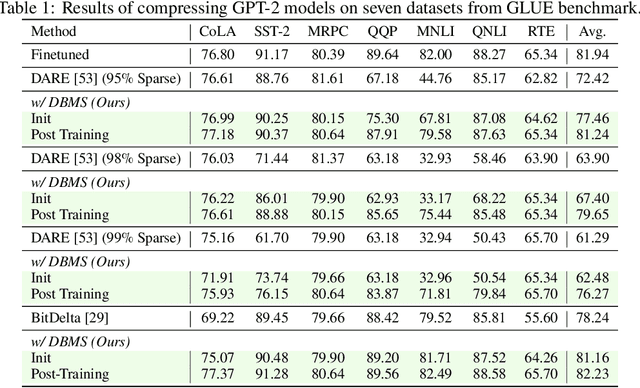

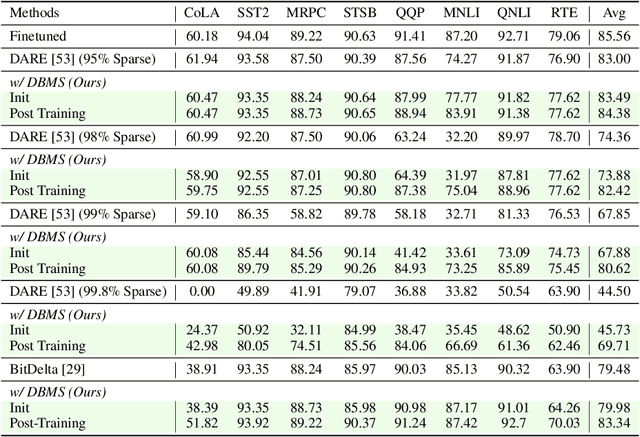
Abstract:Transformer-based models with the pretrain-finetune paradigm bring about significant progress, along with the heavy storage and deployment costs of finetuned models on multiple tasks. Delta compression attempts to lower the costs by reducing the redundancy of delta parameters (i.e., the difference between the finetuned and pre-trained model weights) through pruning or quantization. However, existing methods by default employ the pretrained model as the base model and compress the delta parameters for every task, which may causes significant performance degradation, especially when the compression rate is extremely high. To tackle this issue, we investigate the impact of different base models on the performance of delta compression and find that the pre-trained base model can hardly be optimal. To this end, we propose Dynamic Base Model Shift (DBMS), which dynamically adapts the base model to the target task before performing delta compression. Specifically, we adjust two parameters, which respectively determine the magnitude of the base model shift and the overall scale of delta compression, to boost the compression performance on each task. Through low-cost learning of these two parameters, our DBMS can maintain most of the finetuned model's performance even under an extremely high compression ratio setting, significantly surpassing existing methods. Moreover, our DBMS is orthogonal and can be integrated with a variety of other methods, and it has been evaluated across different types of models including language, vision transformer, and multi-modal models.
Emotion-Qwen: Training Hybrid Experts for Unified Emotion and General Vision-Language Understanding
May 10, 2025Abstract:Emotion understanding in videos aims to accurately recognize and interpret individuals' emotional states by integrating contextual, visual, textual, and auditory cues. While Large Multimodal Models (LMMs) have demonstrated significant progress in general vision-language (VL) tasks, their performance in emotion-specific scenarios remains limited. Moreover, fine-tuning LMMs on emotion-related tasks often leads to catastrophic forgetting, hindering their ability to generalize across diverse tasks. To address these challenges, we present Emotion-Qwen, a tailored multimodal framework designed to enhance both emotion understanding and general VL reasoning. Emotion-Qwen incorporates a sophisticated Hybrid Compressor based on the Mixture of Experts (MoE) paradigm, which dynamically routes inputs to balance emotion-specific and general-purpose processing. The model is pre-trained in a three-stage pipeline on large-scale general and emotional image datasets to support robust multimodal representations. Furthermore, we construct the Video Emotion Reasoning (VER) dataset, comprising more than 40K bilingual video clips with fine-grained descriptive annotations, to further enrich Emotion-Qwen's emotional reasoning capability. Experimental results demonstrate that Emotion-Qwen achieves state-of-the-art performance on multiple emotion recognition benchmarks, while maintaining competitive results on general VL tasks. Code and models are available at https://anonymous.4open.science/r/Emotion-Qwen-Anonymous.
MouseGPT: A Large-scale Vision-Language Model for Mouse Behavior Analysis
Mar 13, 2025Abstract:Analyzing animal behavior is crucial in advancing neuroscience, yet quantifying and deciphering its intricate dynamics remains a significant challenge. Traditional machine vision approaches, despite their ability to detect spontaneous behaviors, fall short due to limited interpretability and reliance on manual labeling, which restricts the exploration of the full behavioral spectrum. Here, we introduce MouseGPT, a Vision-Language Model (VLM) that integrates visual cues with natural language to revolutionize mouse behavior analysis. Built upon our first-of-its-kind dataset - incorporating pose dynamics and open-vocabulary behavioral annotations across over 42 million frames of diverse psychiatric conditions - MouseGPT provides a novel, context-rich method for comprehensive behavior interpretation. Our holistic analysis framework enables detailed behavior profiling, clustering, and novel behavior discovery, offering deep insights without the need for labor - intensive manual annotation. Evaluations reveal that MouseGPT surpasses existing models in precision, adaptability, and descriptive richness, positioning it as a transformative tool for ethology and for unraveling complex behavioral dynamics in animal models.
RankPO: Preference Optimization for Job-Talent Matching
Mar 13, 2025Abstract:Matching job descriptions (JDs) with suitable talent requires models capable of understanding not only textual similarities between JDs and candidate resumes but also contextual factors such as geographical location and academic seniority. To address this challenge, we propose a two-stage training framework for large language models (LLMs). In the first stage, a contrastive learning approach is used to train the model on a dataset constructed from real-world matching rules, such as geographical alignment and research area overlap. While effective, this model primarily learns patterns that defined by the matching rules. In the second stage, we introduce a novel preference-based fine-tuning method inspired by Direct Preference Optimization (DPO), termed Rank Preference Optimization (RankPO), to align the model with AI-curated pairwise preferences emphasizing textual understanding. Our experiments show that while the first-stage model achieves strong performance on rule-based data (nDCG@20 = 0.706), it lacks robust textual understanding (alignment with AI annotations = 0.46). By fine-tuning with RankPO, we achieve a balanced model that retains relatively good performance in the original tasks while significantly improving the alignment with AI preferences. The code and data are available at https://github.com/yflyzhang/RankPO.
Seeing Delta Parameters as JPEG Images: Data-Free Delta Compression with Discrete Cosine Transform
Mar 09, 2025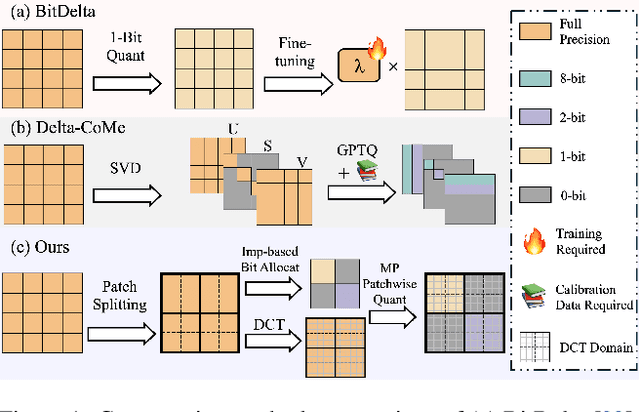



Abstract:With transformer-based models and the pretrain-finetune paradigm becoming mainstream, the high storage and deployment costs of individual finetuned models on multiple tasks pose critical challenges. Delta compression attempts to lower the costs by reducing the redundancy of delta parameters (i.e., the difference between the finetuned and pre-trained model weights). However, existing methods usually face problems including data accessibility and training requirements. To tackle this issue, we introduce Delta-DCT, the first data-free delta compression method inspired by classic JPEG image compression, leveraging the Discrete Cosine Transform (DCT). We first (a) group delta parameters within a layer into patches. Then we (b) assess the importance of each patch and allocate them with different quantization bit-widths. Afterwards, we (c) convert these patches to the DCT domain and conduct quantization to each patch based on the allocated bit-width. The proposed Delta-DCT does not require any training or data calibration, while achieving performance comparable to or even surpassing original finetuned models under 1-bit equivalent delta compression ratios on different kinds of models including: (1) recently-released LLMs of different sizes from 7B to 13B, (2) relatively smaller language models including RoBERTa and T5 models, (3) variants of vision transformer models, and (4) multi-modal BEiT-3 models.
A Powered Prosthetic Hand with Vision System for Enhancing the Anthropopathic Grasp
Dec 10, 2024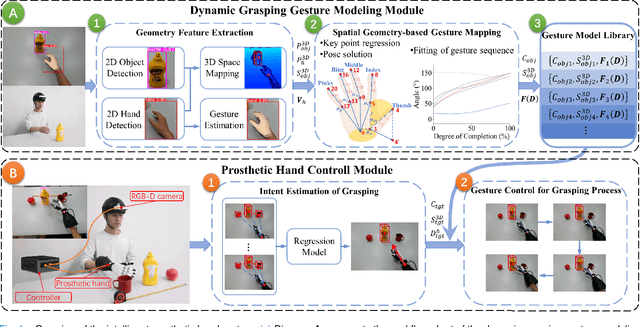
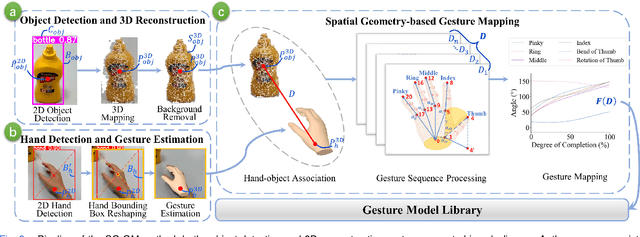
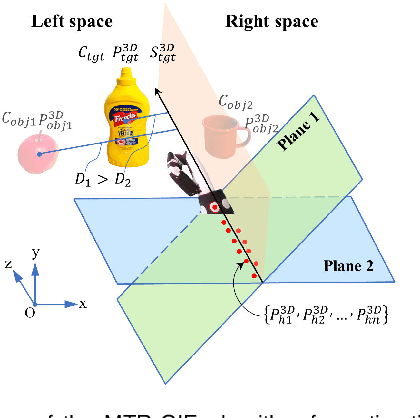
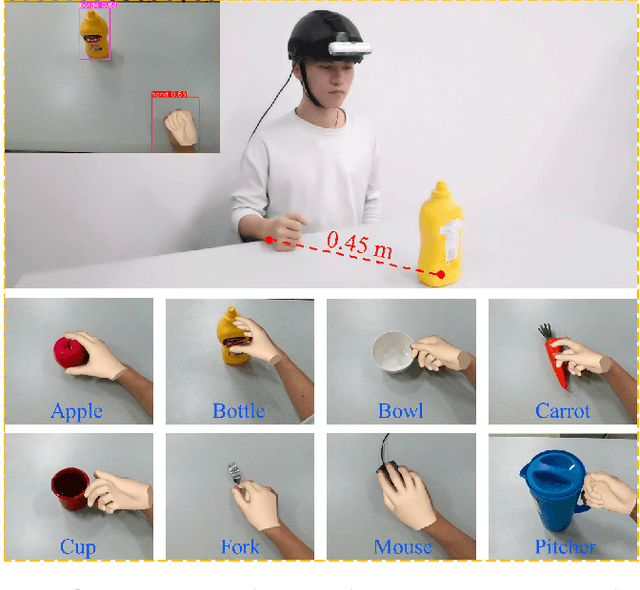
Abstract:The anthropomorphism of grasping process significantly benefits the experience and grasping efficiency of prosthetic hand wearers. Currently, prosthetic hands controlled by signals such as brain-computer interfaces (BCI) and electromyography (EMG) face difficulties in precisely recognizing the amputees' grasping gestures and executing anthropomorphic grasp processes. Although prosthetic hands equipped with vision systems enables the objects' feature recognition, they lack perception of human grasping intention. Therefore, this paper explores the estimation of grasping gestures solely through visual data to accomplish anthropopathic grasping control and the determination of grasping intention within a multi-object environment. To address this, we propose the Spatial Geometry-based Gesture Mapping (SG-GM) method, which constructs gesture functions based on the geometric features of the human hand grasping processes. It's subsequently implemented on the prosthetic hand. Furthermore, we propose the Motion Trajectory Regression-based Grasping Intent Estimation (MTR-GIE) algorithm. This algorithm predicts pre-grasping object utilizing regression prediction and prior spatial segmentation estimation derived from the prosthetic hand's position and trajectory. The experiments were conducted to grasp 8 common daily objects including cup, fork, etc. The experimental results presented a similarity coefficient $R^{2}$ of grasping process of 0.911, a Root Mean Squared Error ($RMSE$) of 2.47\degree, a success rate of grasping of 95.43$\%$, and an average duration of grasping process of 3.07$\pm$0.41 s. Furthermore, grasping experiments in a multi-object environment were conducted. The average accuracy of intent estimation reached 94.35$\%$. Our methodologies offer a groundbreaking approach to enhance the prosthetic hand's functionality and provides valuable insights for future research.
Understanding Parameter Sharing in Transformers
Jun 15, 2023

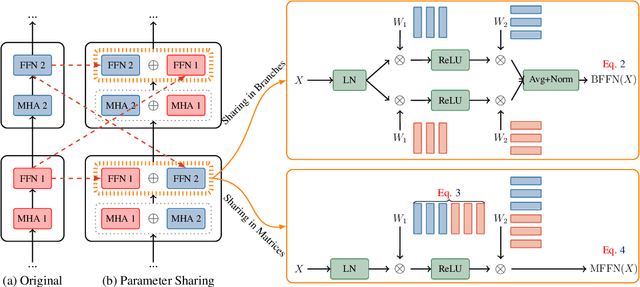

Abstract:Parameter sharing has proven to be a parameter-efficient approach. Previous work on Transformers has focused on sharing parameters in different layers, which can improve the performance of models with limited parameters by increasing model depth. In this paper, we study why this approach works from two perspectives. First, increasing model depth makes the model more complex, and we hypothesize that the reason is related to model complexity (referring to FLOPs). Secondly, since each shared parameter will participate in the network computation several times in forward propagation, its corresponding gradient will have a different range of values from the original model, which will affect the model convergence. Based on this, we hypothesize that training convergence may also be one of the reasons. Through further analysis, we show that the success of this approach can be largely attributed to better convergence, with only a small part due to the increased model complexity. Inspired by this, we tune the training hyperparameters related to model convergence in a targeted manner. Experiments on 8 machine translation tasks show that our model achieves competitive performance with only half the model complexity of parameter sharing models.
 Add to Chrome
Add to Chrome Add to Firefox
Add to Firefox Add to Edge
Add to Edge